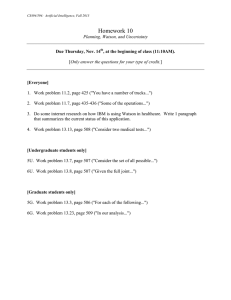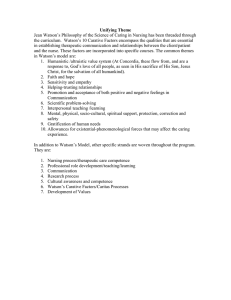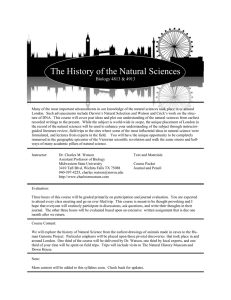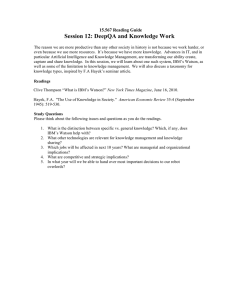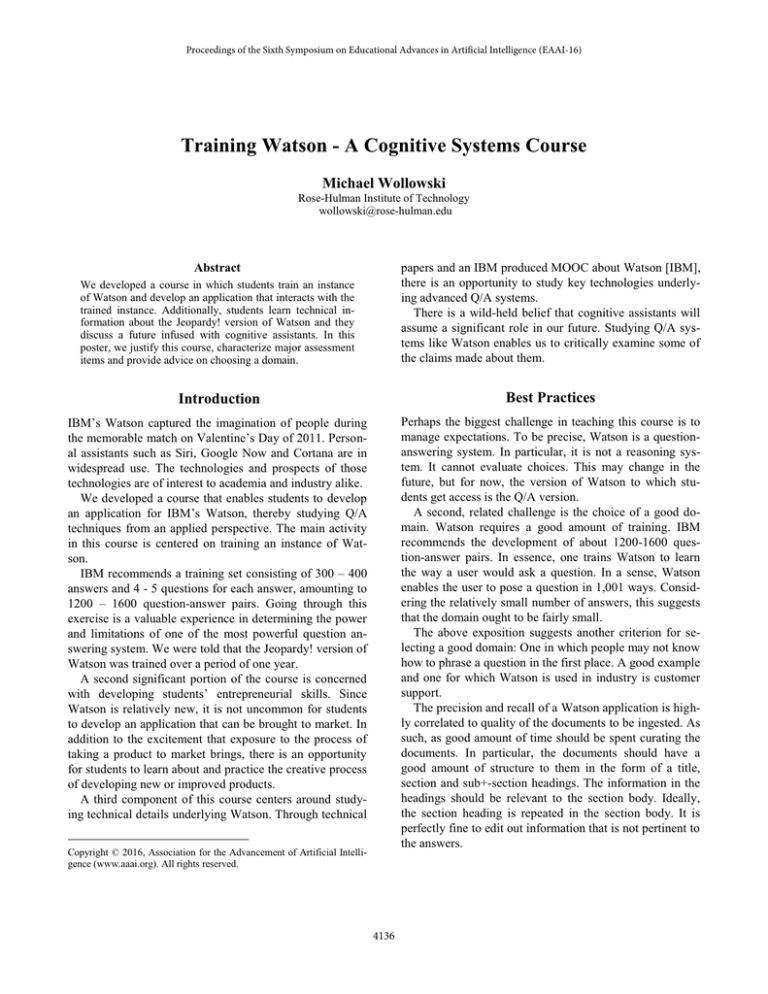
Proceedings of the Sixth Symposium on Educational Advances in Artificial Intelligence (EAAI-16)
Training Watson - A Cognitive Systems Course
Michael Wollowski
Rose-Hulman Institute of Technology
wollowski@rose-hulman.edu
We developed a course in which students train an instance
of Watson and develop an application that interacts with the
trained instance. Additionally, students learn technical information about the Jeopardy! version of Watson and they
discuss a future infused with cognitive assistants. In this
poster, we justify this course, characterize major assessment
items and provide advice on choosing a domain.
papers and an IBM produced MOOC about Watson [IBM],
there is an opportunity to study key technologies underlying advanced Q/A systems.
There is a wild-held belief that cognitive assistants will
assume a significant role in our future. Studying Q/A systems like Watson enables us to critically examine some of
the claims made about them.
Introduction
Best Practices
IBM’s Watson captured the imagination of people during
the memorable match on Valentine’s Day of 2011. Personal assistants such as Siri, Google Now and Cortana are in
widespread use. The technologies and prospects of those
technologies are of interest to academia and industry alike.
We developed a course that enables students to develop
an application for IBM’s Watson, thereby studying Q/A
techniques from an applied perspective. The main activity
in this course is centered on training an instance of Watson.
IBM recommends a training set consisting of 300 – 400
answers and 4 - 5 questions for each answer, amounting to
1200 – 1600 question-answer pairs. Going through this
exercise is a valuable experience in determining the power
and limitations of one of the most powerful question answering system. We were told that the Jeopardy! version of
Watson was trained over a period of one year.
A second significant portion of the course is concerned
with developing students’ entrepreneurial skills. Since
Watson is relatively new, it is not uncommon for students
to develop an application that can be brought to market. In
addition to the excitement that exposure to the process of
taking a product to market brings, there is an opportunity
for students to learn about and practice the creative process
of developing new or improved products.
A third component of this course centers around studying technical details underlying Watson. Through technical
Perhaps the biggest challenge in teaching this course is to
manage expectations. To be precise, Watson is a questionanswering system. In particular, it is not a reasoning system. It cannot evaluate choices. This may change in the
future, but for now, the version of Watson to which students get access is the Q/A version.
A second, related challenge is the choice of a good domain. Watson requires a good amount of training. IBM
recommends the development of about 1200-1600 question-answer pairs. In essence, one trains Watson to learn
the way a user would ask a question. In a sense, Watson
enables the user to pose a question in 1,001 ways. Considering the relatively small number of answers, this suggests
that the domain ought to be fairly small.
The above exposition suggests another criterion for selecting a good domain: One in which people may not know
how to phrase a question in the first place. A good example
and one for which Watson is used in industry is customer
support.
The precision and recall of a Watson application is highly correlated to quality of the documents to be ingested. As
such, as good amount of time should be spent curating the
documents. In particular, the documents should have a
good amount of structure to them in the form of a title,
section and sub+-section headings. The information in the
headings should be relevant to the section body. Ideally,
the section heading is repeated in the section body. It is
perfectly fine to edit out information that is not pertinent to
the answers.
Abstract
Copyright © 2016, Association for the Advancement of Artificial Intelligence (www.aaai.org). All rights reserved.
4136
project through an oral presentation, a technical write-up
and a video demonstration.
The take-home final is designed to think about the future
of Cognitive Computing, i.e. a future in which there are
personal assistants in the form of software applications, in
particular applications that assist people who operate at a
very high level.
Prerequisites
For the first offering of this course, we required our upper
level Artificial Intelligence course as a prerequisite. As
such, we were able to dive fairly deep into the technology
of Watson.
For the next offering, we lowered the prerequisites to
our data structures course. There is a push towards entrepreneurship at our institution and such a move would enable our students to get exposed to entrepreneurship at a
much earlier point in their academic careers.
Conclusions
We taught this course for the first time during the spring of
2015. We since improved the course significantly and the
course documents can be found one our course site [Cognitive Systems Course]. The improvements were based on
student feedback and our own experience teaching the
course.
Our students very much enjoyed the course; in particular, they enjoyed learning about Watson and to work on
something special. We too enjoyed working with our students on a cutting edge project. Our students suggested
bettering the pace of the course by pushing the workload
towards the front of the course. In particular, they suggested starting the project earlier. The course as described here
implements those suggestions.
Absent from this course is a module in which students
present a business proposal to some entity external to this
course, commonly known as “Shark Tanks.” We originally
planned on such a learning component but ran out of time.
Based on our experience with attempting to commercialize our application and discussions with experts in the field
of taking a product to market, we came to the conclusion
that taking a product to market requires skills and experience of a nature that we cannot reasonable teach in two
weeks. As a matter of fact, we believe that the best advice
we can give our students is to network and connect with
people who have business skills that are on par with our
students’ exceptional technical skills.
Assessment
The following types of assignments will be given in this
course and will be used to assess the course objectives.
A. Slides, presentation and write-up justifying a project
idea.
B. Slides, presentation and write-up of a project proposal
(several rounds, recruitment).
C. Presentation of ways in which innovators/artists develop
an idea.
D.Training data and training of our instance of Watson.
E. Project software.
F. Documentation of project through a technical paper, a
slide presentation and a videotaped demo.
G.Reviews of papers, videos and presentations about Watson and Cognitive Systems.
H.Take-home final justifying a future of Cognitive Systems.
I. Participation in class discussions.
Assignments and Activities
There are four kinds of assignments: reviews and presentations (20%), the project proposal phase (20%), the project
phase (50%) and the take-home final (5%), contributing to
the course grade as indicated. The remaining 5% of the
course grade are determined by participation in the course,
largely through participation in class discussions.
The reviews are designed to learn about (i) the inner
workings of Watson as well as (ii) the future impact of
technologies like Watson.
The project proposal phase consists of a four week process in which students will develop an idea for an application, research it, obtain feedback from classmates, and attempt to recruit classmates to join their proposal. If necessary, we conduct a class vote on the domain to be used for
training Watson.
The aim of the project is for our students to gain firsthand experience with training Watson and to learn about
the power and limitation of the most advanced Q/A system.
Additionally, students will gain practice advertising their
References
Cognitive
Systems
Course.
www.rosehulman.edu/class/csse/csse453/watson
Ferrucci, David et.al. 2012. This is Watson. IBM Journal of Research and Development, Issue 3.4
IBM.
Cognitive
Systems
MOOC.
http://www304.ibm.com/services/weblectures/watsonacademy/#discover
IBM Cognitive Systems Institute. Point of View documents.
http://cognitive-science.info/learning-resources/point-of-viewdocuments/
IBM
Watson.
Watson
University
Competition.
https://www.youtube.com/playlist?list=PLZDyxLlNKRY2oGTHZrKILIDz7u4-p3dR
4137

